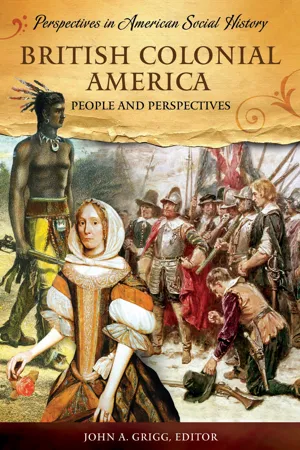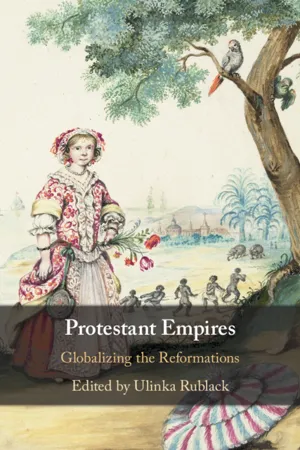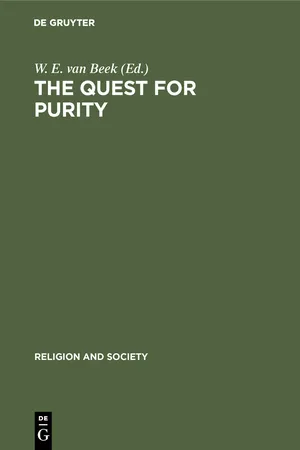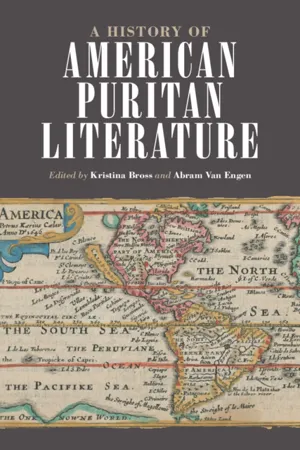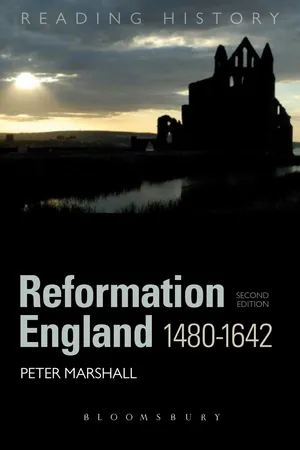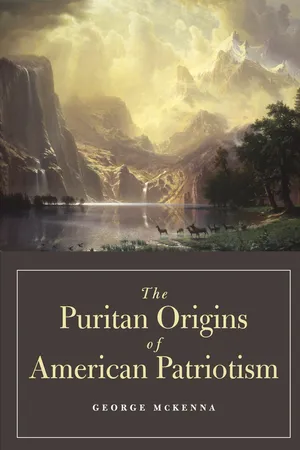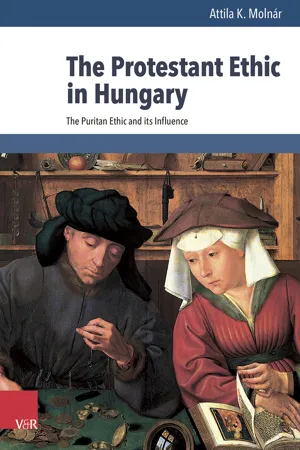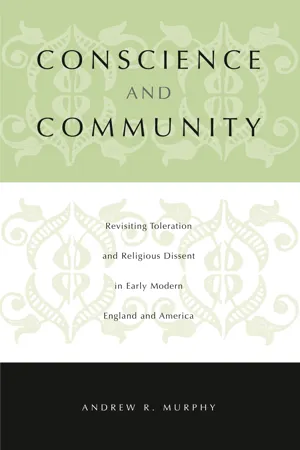History
Puritans
The Puritans were a group of English Protestants in the 16th and 17th centuries who sought to purify the Church of England from within. They emphasized the importance of personal piety, simplicity, and moral purity. The Puritans played a significant role in the colonization of America, particularly in New England, where their religious beliefs and practices influenced the development of early American society.
Written by Perlego with AI-assistance
Related key terms
1 of 5
10 Key excerpts on "Puritans"
- eBook - PDF
British Colonial America
People and Perspectives
- John A. Grigg(Author)
- 2008(Publication Date)
- ABC-CLIO(Publisher)
Puritan Life Michael S. Carter 3 he image of dour, black-clad Puritans forging a new civilization on the rocky shores of New England early in the 17th century is one of the most familiar and cherished in the mythology of American national origins. T But who in fact were these people called Puritans, and do these familiar im- ages of them correspond to historical reality? Why have they received so much attention? Why do they occupy such a prominent place in conven- tional narratives about colonial British North America? It is widely acknowledged by historians that colonial America was among the most religiously diverse, complicated regions in what is known as the early modern era (ca. 1400s–1700s). But before the rise of social history in the 1960s and 1970s, when a wider variety of popular folk traditions and less formal religious practices began to attract the attention of historians, Puri- tans dominated the category of religious history within the broader spectrum of writing about the colonies. The intellectual traditions of the Puritans and their theology—and the vast amount of writing, from sermons to poetry, produced by its leading lights—was brilliantly explored by Perry Miller (1905–1963) beginning in the 1930s. Miller, a Harvard English professor, can be described as the founder of modern Puritan studies. His examination of covenant theology sparked a renaissance of interest in Puritan intellectual history, and led to a greater appreciation for the role of religion in the poli- tics, economics, and culture of colonial America. He also helped to correct perceptions of Puritans as a sour, unhappy people that had been prevalent since 19th-century author Nathaniel Hawthorne wrote his classic fiction based on them, including The Scarlet Letter (1850) and The House of the Seven Gables (1851). - eBook - PDF
Protestant Empires
Globalizing the Reformations
- Ulinka Rublack(Author)
- 2020(Publication Date)
- Cambridge University Press(Publisher)
2 Puritanism in a Local Context: Ministry, People, and Church in 1630s Massachusetts David D. Hall The English women and men who moved to newly founded Massachusetts in the 1630s were experienced travelers of a special kind. Known among themselves as “the godly” and to their countrymen as “Puritans,” they were accustomed to a social, cultural, and theological geography organized around the difference between places deemed “pro- fane” and others deemed pure or “lawful” because they were furnished with “means,” a code-word for evangelical preaching. Catholics, too, were travelers in early Stuart England, but of a different kind. Theirs was a geography of “safe” houses where priests were sheltered and altars secretly maintained alongside outward expressions of loyalty to a Protestant monarch and Protestant state church. Another half-hidden group, the “Familists,” was also practicing a geography that mingled the covert or hidden with accommodation to the larger culture. 1 Important though they were at certain moments in English history, the many rumors about these covert groups was not really what shaped the colonists’ sense of space and its bearing on religion. Instead, they inher- ited a long-standing Puritan-style politics of religion and, more broadly, a politics fostered by the English Reformation. As Alexandra Walsham has shown in Reformation of the Landscape, one version of this politics involved iconoclastic violence aimed at the residues of Catholicism in cemeteries, churches, and other sites. Another version concerned wor- ship, a politics that flared up during the early decades of the seventeenth century when the first two Stuart kings, James I and Charles I, began to favor a group of clergy in the state church who wanted to re-emphasize its connections with Catholicism at the expense of connections with the Reformed tradition. - eBook - PDF
The Quest for Purity
Dynamics of Puritan Movements
- W. E. van Beek(Author)
- 2019(Publication Date)
- De Gruyter(Publisher)
Patterns of purification: the New England Puritans Peter Staples The pattern of migration: from old to New England Purity and Church order The purification of self: beliefs and piety Abolishing outward sacredness Puritan patterns of child-rearing Contradictions and aberrations References Patterns of purification: the New England Puritans Peter Staples When Richard Rogers, a seventeenth-century English Puritan, was told that his conduct was too 'precise', he replied by observing that he served a 'precise' God, thus confirming that there is at least a modicum of truth in predicates such as 'precisionist' (or Puritan) which were first used by the opponents of radical Protestantism (Greven 1977: 141). But it would surely be quite misleading to presuppose that Puritans simply tried to identify a certain ontological 'something' called 'purity' and then strived for it. As Perry Miller rightly observed, the Puritans originally set out to purify an institution (Gilmore 1980:23). The main purification was to be a purging of the Church of England from all the remnants of medieval Catholicism which had survived the partial reforms of Henry VIII, Edward VI and Queen Elizabeth: e.g. the wearing of the surplice during divine worship; the use of the sign of the cross in the baptismal liturgy; and the ring in marriage. Originally, Puritanism was a protest against the 'half-way^ measures which were prescribed (and enforced) by 'Anglican' and Lutheran Princes,: both in England and in Northern Europe. Its stated intention was to return to the pris-tine purity of the original Christians, as described in the Acts of the Apostles, and to establish a society or polity based upon the Ten Com-mandments, which would be preached by properly appointed Ministers of the Word and enforced by the local magistrates and the godly elders. 'Insofar as a religious motivation propelled Englishmen to emigrate to New England, that impulse was not theological but ecclesiastical. - Carla Gardina Pestana(Author)
- 2009(Publication Date)
- Harvard University Press(Publisher)
45 Massachusetts pressured 133 Religious Politics of a “Puritan Revolution” 133 other New England colonies, most notably Plymouth, to adopt its practices on specific problems such as ministerial maintenance and the punishment of heresy. The government even supported—albeit modestly—the campaign to convert Native Americans, though the program was not popular with settlers. The missions to the Indians strove not just to make the natives into Christian men and women but also to pattern them upon godly English men and women. This impulse to monitor the conduct of potential converts was in keeping with the more general drive to reform manners. Given the cross-cul-tural component of their journey into Christianity, Native Americans faced a greater challenge than did other objects of reform; the uninitiated rarely found it easy to satisfy the demands of godly reformation, however. 46 The Somers Islands and Plymouth Plantation moved during this era to-ward the sort of religious establishment that the three orthodox New Eng-land colonies boasted. Plymouth had not originally pursued a reform agenda, although others in the region recognized its churches as broadly orthodox. Plymouth’s unique history helps explain its initial lack of attention to this project, so dear to the founders of Massachusetts, New Haven, and Connect-icut. The religious separatism of some of the first settlers, their experience as exiles in the tolerant Netherlands, the tenuous legal basis for the settlement, and the presence of a large number of “Strangers” in the plantation all dis-couraged the creation of a vigorous polity supporting reform. By 1650, how-ever, Plymouth was prepared to move in the direction charted by some of its neighbors.- eBook - PDF
- Kristina Bross, Abram Van Engen(Authors)
- 2020(Publication Date)
- Cambridge University Press(Publisher)
Henry Cabot Lodge, The Pilgrims of Plymouth: An Address at Plymouth, Massachusetts, on the Three Hundredth Anniversary of Their Landing, December , (Boston: Pilgrim Tercentenary Commission, ). Since winter is no time to hold such a pageant in Massachusetts, the planners had postponed the tribute to the following summer. Report of the Pilgrim Tercentenary Commission (Boston: Wright and Potter, ), , , box , Pilgrim Tercentenary Commission Records, –, Massachusetts Historical Society, Boston, MA. Prologue: Pilgrims, Puritans, and the Origin of America Creating the Puritans Before we can understand what has changed about Pilgrim and puritan origin stories a century later, however, we have to see how and why scholars shifted attention from these overly feted Mayflower voyagers to their relatively less admired northern neighbors, the Puritans. While the Pilgrims commanded an audience of presidents and politicians, the puri- tans had far less appeal. Still today, we recognize a common split in American collective memory about these two sets of people, even as they are often blended together as one common origin. “Pilgrim” is a term associated mostly with positive connotations in Anglo-American culture: noble, brave, daring, determined, devout. “Puritan,” however, brings up far different associations: scary, angry, pleasure-hating, dogmatic, oppressive. Television shows, movies, and popular novels often present the Puritans not as the bringers of freedom but as the original force of repression against which brave souls once fought for the liberties we now enjoy. Such a tradition began in earnest in the late nineteenth century. During the height of the Victorian era, historians and cultural critics began to see the Puritans as moralists who hated any and every good thing worth having. - eBook - PDF
- Peter Marshall(Author)
- 2012(Publication Date)
- Bloomsbury Academic(Publisher)
Gallons of ink and mountains of printer cartridges have been expended in debates about what (if anything) the term actually means, about whether Puritanism should be considered a ‘movement’, and about the significance and depth of the divisions Puritanism promoted both locally and nationally in English society. Once, the matter seemed straightforward enough. Puritans were the opponents of Anglicans. The latter were the religious main-stream, upholders of the moderate Anglican ecclesiastical settlement established by law in 1559 and assailed by papists from the one extreme and Puritans from the other. 3 This interpretation has fallen dramatically from favour in recent decades. Not only was the word ‘Anglican’ virtually unknown before the mid-seventeenth century, but Anglicanism in the commonly understood modern sense – a distinctive version of Christianity synthesizing Catholic and Protestant strands – simply did not exist in the Tudor period, other than in the minds of a few eccentric individuals. The leading Elizabethan clergy thought of them-selves as Protestants, and of their Church as part of the ‘Reformed’ family of European Protestant Churches – that is those aligned with Calvinism rather than Lutheranism. Even the juxtaposition of ‘Protestantism’ and ‘Puritanism’ in the title of this chapter might be misleading. The foremost historian of Elizabethan and Jacobean Puritanism, Patrick Collinson, argued over many decades that the phenomenon is best understood not as a species of ‘opposition’, but as a tendency or impulse largely contained within the Protestant mainstream, and sharing many of its concerns. 4 But if simplistic Anglican/Puritan dichotomies have largely been abandoned as a means of understanding the progress of the later Reformation, there remains 2 Diarmaid MacCulloch, The Later Reformation in England, 1547–1603 (2nd edn, Basingstoke, 2001), Chapter 3. 3 For example, M. M. Knappen, Tudor Puritanism (Chicago, 1939); J. - eBook - PDF
- George McKenna(Author)
- 2008(Publication Date)
- Yale University Press(Publisher)
Randolph Bourne, one of those critics who blamed the sexual repression of the 1890s on the Puritans, confessed that ‘‘if there were no Puritans we should have to invent them.’’ ≤Ω Still, we need not leap to the conclusion that there was no ‘‘there’’ there in the first place. The Puritans were involved, even if the causality was only indirect. The evangelical Awakening movements that played a role in shaping the cul-ture of American Victorianism were themselves influenced by the ten-sions and spiritual longings of seventeenth-century Puritanism. The distinctive brand of American patriotism begun in the mid– seventeenth century had its geographical origins in New England and its religious origins in Calvinist Protestantism. Yet it adapted itself well to change. By the early nineteenth century the ‘‘New England diaspora’’—the steady march of Puritan-influenced settlers from New England across the 10 introduction upper Midwest to northern Illinois and parts of Iowa, Missouri, Kansas, and eventually to the Pacific Northwest—brought much of the culture of New England Protestantism into the entire North. Theologically, Puritan-ism in the nineteenth century acquired some of the tendencies of other Protestant denominations, particularly those of the fast-growing Baptists and Methodists. Whatever their di√erences from these other sects, the Puritan-influenced Congregationalists and Presbyterians shared with them an emphasis on the individual’s direct relationship to God, an insis-tence upon the Bible as the sole source of God’s word, a belief that the ‘‘born again’’ experience constitutes strong evidence of justification, ac-ceptance of personal responsibility for bringing the word of God to others, and a preference for some form of democracy in church governance. ≥≠ In the North, they shared a strong emphasis upon reform, which meant not only changing people’s personal habits but changing institutions and practices they regarded as sinful. - eBook - PDF
The Protestant Ethic in Hungary
The Puritan Ethic and its Influence
- Attila K. Molnár(Author)
- 2024(Publication Date)
- Vandenhoeck & Ruprecht(Publisher)
II. The history of Puritanism in Hungary In the heyday of Puritanism in the 17 th century, Hungary was one of the main centres of the movement, after England and Holland. This was due in part to developments in Calvinism and in Hungarian society in general, but more particularly to the prevailing political conditions. As in the case of other religious movements or wing, there was no clear boundary of the movement, practically in case of Hungary they were a branch of Calvinist preachers discontented with the ecclesiastical hierarchy and the liturgy, on the one hand, and with the superficial religiosity of their flocks on the other hand. Let me say that “the final and definitive concept cannot stand at the beginning of the investigation but must come at the end”. 1 The Hungarian Puritanism aimed to purify the Reformed Church of the remnants of feudalism and Catholicism, which were in abundance in the Hungarian Reformed (Calvinist) Church. Its followers also wanted to achieve a greater degree of religiosity in society, as they felt that it the Church had become rather formalised for most people. According to the Puritans, Christianity had lost its ability to shape the lifestyles and deeds of its adherents, even those among the clergy. The Hungarian Reformed Church retained an episcopal polity (bishop system), which meant that congregations depended on the church hierarchy. In addition to this, because of the social system of patronage, lay feudal lords had a decisive say in the life of the congregation and the “condemnation” of preachers to a great extent. 2 The preacher was at the mercy of his feudal lord, and of his bishop, who had the right to appoint him, remove him from his position, or transfer him to another congregation. At the same time the preachers were beginning to assume the character of orders, as for example when the Prince of Transylvania nobilitated all the preachers at Bethlen in 1629 and granted them the right to send representatives 1 M. - eBook - PDF
Realist Strategies of Republican Peace
Niebuhr, Morgenthau, and the Politics of Patriotic Dissent
- V. Tjalve(Author)
- 2008(Publication Date)
- Palgrave Macmillan(Publisher)
Fusing puritan theology with pioneer pragmatism, American political discourse must be approached as a struggle fought out within the confines of a shared ambition: to apply ideology—not refine it (Boorstein 1958: 6). European Trajectories: The Roots of Puritan Exceptionalism In this commitment to active human change, the Puritans took for granted a particular conception of the individual. For human beings to be able to act on the part of God, and hence for the temporal to be intertwined with the divine, an altogether less humble notion of the capacities of human kind than that which had characterized early Christianity was required. How did this emerge? The answer begins with the Protestant Reformation of sixteenth-century Europe, more specifically with the puritan movement in Britain, and the Lutheran and Calvinist ones on the continent (Persons 1958: 4). Though in several ways an attempt to return to the classical doctrines of Augustinian piety (354–430 AD), the theology of the reformed churches—whether puritan, Calvinist, Pietist, or Methodist—must be rec- ognized as a child of the Enlightenment and the three interrelated processes of modernization this entailed (Epp 1991: 3). First of all, the Reformation marked a growing rationalization of religious life, emphasizing the need for the individual believer to perform, as a sign of faith, perpetual and systematized good works. Second, and related to this, a strengthened individualization of religious life was both the product of and a driving force behind reformist systematization, stressing the irreducibly personal nature of faith. Finally, the Reformation invoked a dramatic externalization of religion, enabling a marriage between practical and spiritual dimensions to life. - eBook - PDF
Conscience and Community
Revisiting Toleration and Religious Dissent in Early Modern England and America
- Andrew R. Murphy(Author)
- 2001(Publication Date)
- Penn State University Press(Publisher)
59. Seligman, Innerworldly Individualism, chap. 5. On the jeremiad as an enduring cultural and rhetorical form, see Sacvan Bercovitch, The Puritan Jeremiad (Madison, Wis., 1978). as well as earlier generations of Puritans protesting against Anglo-Catholic “innovation.” 60 Epistemologically and cosmologically, the context for New England Puritanism remained the context of the Protestant Reformation more generally: the drive for religious truth looked, not forward, but to a pristine past. As Perry Miller puts it, “Puritan theory . . . was only in a slight degree progres- sive; it was for the most part the elaborate restatement of a medieval ideal.” 61 The further Reformation in New England represented “a drive toward origins,” to use Theodore Bozeman’s phrase, a move forward in providential history by seeking a primitive purity. One must not stray too far from God’s revealed plan, since “the presumed right to contrive new structural or theo- logical forms not found among the first was the opening wedge which had admitted the myriad errors of popish religion.” 62 Biblicism joined with primi- tivism in opposing both diversifying tolerationist impulses in religion and the human inventions of the Anglican and Catholic traditions. Joseph Lecler, in describing early English Puritans, could have been describing New England Puritans: “[They] were not so much defenders of conscience as champions of the Bible.” 63 46 Revisiting Early Modern Toleration and Religious Dissent 60. In his letter to Winthrop of 24 October 1636 Williams claims only to seek the simplicity of Christ and the early church (The Correspondence of Roger Williams, ed. Glenn W. Lafantasie [Hanover, N.H., 1988], 1:65–69).
Index pages curate the most relevant extracts from our library of academic textbooks. They’ve been created using an in-house natural language model (NLM), each adding context and meaning to key research topics.
